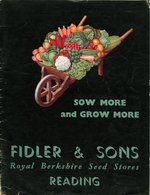The OSU Seed and Nursery Trade catalogue collection contains over 2,000 items from 1832 to 1966. While the collection is most comprehensive in its representation of American catalogues from the 1940s, it contains many older examples from North America, Great Britain, and Holland, as well other European and Asian countries. Former agricultural librarian Laura Kelts compiled the collection from various sources in the 1960s and 1970s. At that time, it was stored in a locked room of the science area of the library, where space was at a premium. In 1986, the new Special Collections unit was formed and the collection was moved there, where it resides today.
Seed and nursery trade catalogues are lists of seeds or plants available for sale. Many of the oldest surviving printed catalogues are not much more than lists, divided into categories by plant type such as vegetables, sweet and medicinal herbs, flowers, and bulbous roots. Today, we expect a catalogue to contain much more: prices, shipping and ordering information, illustrations, product descriptions, and growing instructions. Catalogues often include pre-selected assortments, special offers, customer testimonials, and a way to contact the company to ask questions by phone, fax, or email. Rather than offering merely seeds and plants, catalogues offer garden tools, kitchen gadgets, gardening clothes and furniture. Recipes, personal notes from company owners, and evidence of companies’ charitable works are all common elements in modern retail catalogues. The study of older seed and nursery catalogues makes it possible to trace how and when these developments occurred in response to available technology and the demands of gardeners in changing times.

